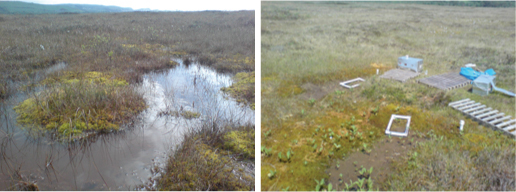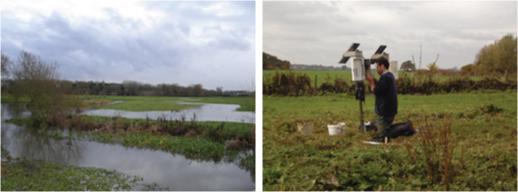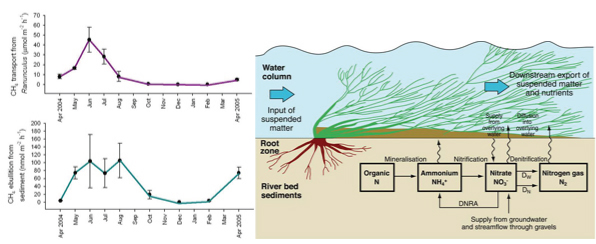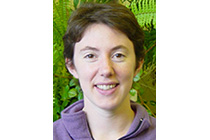Profile
My research is focused on the transport and transformation of contaminants and pollutants as they move through lowland river catchments and undergo exchanges at the interface of land, water and atmosphere. My research poses globally significant questions such as:
- How do hydrological and biogeochemical processes, in different landscape settings, interact to remove excess nutrients from our rivers?
- How might flooding by nutrient-rich freshwaters affect greenhouse gas fluxes?
Important research achievements include quantification of a little-measured nitrogen transformation process (DNRA) in soils and sediments (Sgouridis et al., 2011; Lansdown et al., 2012); establishing the extent to which macrophytes control the magnitude and timing of sediment storage in a chalk river (Heppell et al., 2009); measuring and highlighting the potential importance of in-stream mineralisation of organic carbon and nitrogen (Sanders et al., 2007; Trimmer et al., 2009); and quantifying the importance of methane ebullition in northern peatlands (Stamp et al., 2013).
Key publications are:
- Lansdown K, Heppell CM, Trimmer M, Binley A, Heathwaite AL, Byrne P, Zhang H (2015) The interplay between transport and reaction rates as controls on nitrate attenuation in permeable, streambed sediments. Journal of Geophysical Research: Biogeosciences. doi: 10.1002/204JG002874.
- Lansdown K, Heppell CM, Dossena M, Ullah S, Heathwaite AL, Binley A, Zhang H & Trimmer M 2014. Fine-scale in situ measurement of river bed nitrate production and consumption in an armored permeable river bed. Environmental Science &Technology, doi: 10.1021/es4056006.
- Heppell CM, Heathwaite AL, Binley A, Byrne P, Ullah S, Lansdown K, Keenan P, Trimmer M & Zhang H 2013. Interpreting spatial patterns in redox and coupled water-nitrogen fluxes in the streambed of a gaining river reach. Biogeochemistry, doi: 10.1007/s10533-013-9895-4.
- Heppell CM, Wharton, G, Cotton, JAC, Bass, JAB & Roberts, SE 2009. Sediment storage in the shallow hyporheic of lowland vegetated reaches. Hydrological Processes, 23(15), 2239–2251.
- Sgouridis F, Heppell CM, Trimmer M, and Wharton G 2011. Denitrification and dissimilatory nitrate reduction to ammonium (DNRA) in a temperate re-connected floodplain. Water Research, 45(16), 4909-4922.
- Lansdown K, Trimmer M, Heppell CM, Sgouridis F, Ullah S , Heathwaite AL , Binley A and Zhang H 2012. Characterisation of the key pathways of dissimilatory nitrate reduction and their response to complex organic substrates in hyporheic sediments. Limnology and Oceanography 57(2), 387–400.
- Sanders I, Heppell CM, Cotton JA, Wharton G, Hildrew A, Flowers EJ & Trimmer M 2007. Emission of methane from chalk streams has potential implications for agricultural practices. Freshwater Biology, 52(6), 1176–1186.
- Trimmer M, Grey J, Heppell CM, Hildrew AG, Lansdown K, Stahl H, Yvon-Durocher G 2012. River bed carbon and nitrogen cycling: state of play and some new directions. Science of the Total Environment, 434,143–158.
- Stamp I, Baird A & Heppell CM (in press). The importance of ebullition as a mechanism of methane (CH4) loss to the atmosphere in northern peatlands Journal of Geophysical Research.
Teaching
Lectures are taught in an informal style with emphasis on encouraging student contribution and discussion. I also specialise in hands-on laboratory and fieldwork teaching that encourages active student learning through experience. An example of this would be at Level 7 where students explore a current research question ‘What controls the production of carbon dioxide in different sediment patches in a chalk river?’ through a field visit combined with intensive 4-day laboratory experiments. They write up the report as a ‘short communication’ research article.
Key undergraduate and postgraduate contributions to teaching include:
Level 4: GEG4303 Practical Environmental Investigations
Level 5: GEG5203 Earth System Cycles
Level 6: GEG6218 Integrated Catchment Management
Level 7: GEG7318 Catchment Science in Practice; GEG7313 Biogeosciences and Ecosystem Services
Student feedback on GEG6218, 2013: ‘Kate Heppell teaches the module really well. It is stimulating because we are actually learning something completely new which we haven’t done before’.
Student feedback on GEG7303, 2013: ‘Thanks a lot for the interesting and well organised course!’.
Research
Research Interests:
NERC Consortium Award (NE/J012106/1) The role of lateral exchange in modulating the seaward flux of C, N, P.

This consortium project is aimed at quantifying both the flux and dynamics of the lateral exchange of organic carbon between landscape and rivers, and how this in turn modulates the transport of nitrogen and phosphorus towards the coast. Our research aims to understand the movement of these macronutrients through the different tributaries of the River Avon in Wiltshire, and how the movement of these different macronutrients varies across the different geological settings (clay, chalk and sandstone) through which the river flows. A summary document of preliminary findings can be downloaded here [PDF 2,695KB].
This research is being funded by the UK Natural Environment Research Council as part of the Macronutrient Cycles thematic programme. Further information about the programme can be found at the following website:
http://www.nerc.ac.uk/research/programmes/macronutrient/
Defra Consortium Award. Lowland peatland systems in England and Wales – evaluating greenhouse gas fluxes and carbon balances.

Lowland peat soils occupy a relatively small proportion of the overall peatland area in England and Wales, but store large amounts of carbon (C) and are subject to disproportionately high levels of land-use pressure. To date, most measurements of C and greenhouse gas (GHG) fluxes from UK peatlands have been made within upland blanket bogs, and it is doubtful whether the data obtained from these studies can be extrapolated to lowland systems. This study will provide a new comprehensive assessment of the GHG fluxes and C balance of the lowland peatland systems in England and Wales.
NERC Standard Grant (split award; NE/F004753/1) Implications of groundwater-surface water connectivity for nitrogen transformations in the hyporheic zone

The interaction of groundwater-surface water in the hyporheic zones of rivers during baseflow conditions, and its influence on nitrogen transport and transformations are poorly understood at a river reach scale. The predicted changes in precipitation and temperature linked to climate change may have further repercussions on the nature and extent of hydrologic exchanges in the hyporheic zones and biogeochemical processes. This project sought to elucidate both physical and chemical controls on nitrogen transport and transformations in the hyporheic zone of a groundwater fed river in Cumbria, UK. The project used a multidisciplinary approach to explore the physical hydrology, hydrogeophysics and biogeochemistry controls on N transport in the hyporheic zone of River Leith at a reach scale. The project had the following objectives:

- To identify how riverbed physical structure and permeability controls rates and magnitude of groundwater-surface water flux.
- To establish if spatial heterogeneity in the hyporheic zone leads to redox-sensitive biogeochemical “hotspots” and “hot events” that determine the rate of N transport and transformations linked to variations in the riverbed connectivity.
Click here for link to website at Lancaster University.
Publications to date arising from this work:

- Binley A, Ullah S, Heathwaite AL, Heppell CM, Byrne P,Lansdown K, Trimmer M, Zhang H (in press). Revealing the spatial variability of water fluxes at the groundwater-surface water interface. Water Resources Research.
- Ullah S, Zhang H, Heathwaite AL, Binley A, Lansdown K, Heppell K, Trimmer M 2012. In situ measurement of redox sensitive solutes at high spatial resolution in a riverbed using Diffusive Equilibrium in Thin Films (DET). Ecological Engineering, 28(2), 131-140
Research findings and method development arising from this project have contributed to a new NERC funded project entitled ‘The role of lateral exchange in modulating the seaward flux of C, N, P’. See here for further details.
Publications
Full list of publications
Journal articles
- Lansdown K, McKew B, Whitby C, Dumbrell A, Heppell C, Binley A, Olde L & Trimmer M (in press) Riverine anaerobic ammonium oxidation across contrasting geologies. Accepted for publication in Nature Geosciences.
- Clilverd H, Thompson JR, Heppell CM, Sayer CD & Axmacher JC (in press) Coupled hydrological/hydraulic modelling of river restoration impacts and floodplain hydrodynamics. Accepted for publication in River Research and Applications.
- Jin L, Whitehead PG, Heppell CM, Lansdown K, Purdie DA, Trimmer M. (2016) Modelling flow and inorganic nitrogen dynamics on the Hampshire Avon: Linking upstream processes to downstream water quality. Science of the Total Environment doi: 10.1016/j.scitotenv.2016.02.156.
- Laws J, Heppell K, Sheahan D, Liu C-F, Grey J (2016) No such thing as a free meal: organotin transfer across the freshwater-terrestrial interface. Freshwater Biology, doi: 10.1111/fwb.12733.
- Boyle JF, Sayer CD, Hoare D, Bennion H, Heppell K, Lambert SJ, Appleby PG, Rose NL, Davy AJ (2016) Toxic metal enrichment and boating intensity: sediment records of antifoulant copper in shallow lakes of eastern England. Journal of Palaeolimnology. 55, 195-208. doi: 10.1007/s10933-015-9865-z
- Lansdown K, Heppell CM, Trimmer M, Binley A, Heathwaite AL, Byrne P, Zhang H (2015) The interplay between transport and reaction rates as controls on nitrate attenuation in permeable, streambed sediments. Journal of Geophysical Research: Biogeosciences. doi: 10.1002/204JG002874.
- Byrne P, Zhang H, Ullah S, Binley S, Binley A, Heathwaite AL, Heppell CM, Lansdown K, Trimmer M (2015) Diffusive equilibrium in thin films provides evidence of suppression of hyporheic exchange and large-scale nitrate transformation in a groundwater-fed river. Hydrological Processes 29(6), 1385-1396.
- Meijles EW, Dowd JF, Williams AG, Heppell CM (2014) Generation of stom runoff and the role of animals in a small upland headwater stream. Ecohydrology.doi: 10.1002/eco.1584
- Hu H, Binley A, Heppell CM, Lansdown K, Mao X (2014) Impact of microforms on nitrate transport at the groundwater-surface water interface in gaining streams. Advances in Water Resources 73, 185-197.
- Gibbs HM, Gurnell AM, Heppell CM, Spencer KL (2014) The role of vegetation in the retention of fine sediment and associated metal contaminants in London’s rivers. Earth Surface Processes and Landforms 39(8), 1115-1127.
- Lansdown K, Heppell CM, Dossena M, Ullah S, Heathwaite AL, Binley A, Zhang H & Trimmer M 2014. Fine-scale in situ measurement of river bed nitrate production and consumption in an armored permeable river bed. Environmental Science &Technology, doi: 10.1021/es4056006.
- Ullah S, Zhang H, Heathwaite L, Heppell CM, Lansdown A, Binley A & Trimmer M 2014. Influence of emergent vegetation on nitrogen cycling in sediments of a groundwater-fed river. Biogeochemistry, 118(1-3), 121-134.
- Heppell CM, Heathwaite AL, Binley A, Byrne P, Ullah S, Lansdown K, Keenan P, Trimmer M & Zhang H 2013. Interpreting spatial patterns in redox and coupled water-nitrogen fluxes in the streambed of a gaining river reach. Biogeochemistry, doi: 10.1007/s10533-013-9895-4.
- Clilverd HM, Thompson JR, Heppell CM, Sayer CD, Axmacher JC 2013. River-floodplain hydrology of an embanked lowland Chalk river and initial response to embankment removal. Hydrological Sciences Journal. 58(3), 627-650.
- Byrne P, Binley A, Heathwaite AL, Ullah S, Heppell CM, Lansdown K, Zhang H, Trimmer M & Keenan P 2013. Control of river stage on the reactive transport of the hyporheic zone. Hydrological Processes, doi: 10.1002/hyp.9981
- Stamp I, Baird A & Heppell CM 2013. The importance of ebullition as a mechanism of methane (CH4) loss to the atmosphere in a northern peatland. Geophysical Research Letters, doi: 10.1002/grl.50501.
- Binley A, Ullah S, Heathwaite L, Heppell CM, Byrne P, Lansdown L, Trimmer M & Zhang H 2013. Revealing the spatial variability of water fluxes at the groundwater-surface water interface. Water Resources Research, 49, 1-15, doi: 10.1002/wrxr.20214.
- Ullah S, Zhang H, Heathwaite AL, Binley A, Lansdown K, Heppell K, Trimmer M 2012. In situ measurement of redox sensitive solutes at high spatial resolution in a riverbed using Diffusive Equilibrium in Thin Films (DET). Ecological Engineering, 28(2), 131-140
- Kadiri M, Spencer K and Heppell CM 2012. Potential contaminant release from agricultural soil and dredged sediment following managed realignment. Journal of Soils and Sediments, 12(1), 1581-1592.
- Trimmer M, Grey J, Heppell CM, Hildrew AG, Lansdown K, Stahl H, Yvon-Durocher G 2012. River bed carbon and nitrogen cycling: state of play and some new directions. Science of the Total Environment, 434,143-158.
- Lansdown K, Trimmer M, Heppell CM, Sgouridis F, Ullah S , Heathwaite AL , Binley A and Zhang H 2012. Characterisation of the key pathways of dissimilatory nitrate reduction and their response to complex organic substrates in hyporheic sediments. Limnology and Oceanography 57(2), 387-400.
- Sgouridis F, Heppell CM, Trimmer M, and Wharton G 2011. Denitrification and dissimilatory nitrate reduction to ammonium (DNRA) in a temperate re-connected floodplain. Water Research, 45(16), 4909-4922.
- Kadiri M, Spencer K, Heppell CM 2011. Sediment characteristics of a restored saltmarsh and mudflat in a managed realignment scheme in south-east England. Hydrobiologia, 672(1), 79-89.
- Krause S, Hannah DM, Fleckenstein JH, Heppell CM, D Kaeser, R Pickup, G Pinay, AL Robertson and PJ Wood 2011. Inter-disciplinary perspectives on processes in the hyporheic zone. Ecohydrology, 4(4), 481-499.
- Baird A, Stamp I, Heppell CM & Green S 2010. Technical paper: CH4 flux from peatlands: a new measurement method. Ecohydrology, 3, 360-367.
- Heppell CM, Wharton, G, Cotton, JAC, Bass, JAB & Roberts, SE 2009. Sediment storage in the shallow hyporheic of lowland vegetated reaches. Hydrological Processes, 23(15), 2239-2251.
- Trimmer, M, Sanders, IA, & Heppell CM, 2009. Carbon and nitrogen cycling in a vegetated lowland chalk river impacted by sediment. Hydrological Processes, 23(15), 2225-2238.
- Sanders I, Heppell CM, Cotton JA, Wharton G, Hildrew A, Flowers EJ & Trimmer M 2007. Emission of methane from chalk streams has potential implications for agricultural practices. Freshwater Biology, 52(6), 1176-1186.
- Cundy AB, Lafite R, Taylor JA, Hopkinson L, Deloffre J, Charman R, Gilpin M, Spencer KL, Carey PJ, Heppell CM, Ouddane B, De Wever S, Tuckett A. Source: Sediment transfer and accumulation in two contrasting salt marsh/mudflat systems: the Seine estuary (France) and the Medway estuary (UK) 2007. Hydrobiologia, 588: 125-134.
- Cotton JA, Wharton G, Bass JAB, Heppell CM & Wotton RS 2006. Plant-water-sediment interactions in lowland permeable streams: investigating the effect of seasonal changes in vegetation cover on flow patterns and sediment accumulation. Geomorphology, 77, 320-334.
- Wharton G, Cotton JA, Wotton RS, Bass JAB, Heppell CM, Trimmer M, Sanders IA and Warren L 2006. Engineering of flows and fine sediments by macrophytes and suspension-feeding invertebrates in the Frome and Piddle Catchments, Dorset (UK). Journal of Hydrology, 330, 171-184.
- Heppell CM and Chapman AS 2006. Analysis of a two-component hydrograph separation model to predict herbicide runoff in drained soils. Agricultural Water Management, 79, 177-207.
- Cundy AB, Hopkinson L, Lafite R, Spencer K, Taylor JA, Ouddane B, Heppell CM, Carey PJ, Charman R, Shell D and Ullyott S 2005. Heavy metal distribution and accumulation in two Spartina sp.-dominated macrotidal salt marshes from the Seine estuary (France) and the Medway estuary (U.K.) Applied Geochemistry, 20(6), 1195-1208.
- Heppell CM, Chapman AS, Bidwell VJ, Forrester G & Kilfeather AA 2004. A lysimeter experiment to investigate the effect of surface sealing on hydrology and pesticide loss from the reconstructed profile of a clay soil. Part 1. Hydrological Processes. Soil Use & Management, 20, 373-383.
- Heppell CM, Chapman AS, Bidwell VJ & Kilfeather AA 2004. A lysimeter experiment to investigate the effect of surface sealing on hydrology and pesticide loss from the reconstructed profile of a clay soil. Part 2. Pesticide Loss. Soil Use & Management, 20, 384-393.
- Jenns N, Heppell CM, Burt TP, Walden J and Foster IDL 2002. Investigating contemporary and historical sediment inputs to Slapton Higher Ley: an analysis of the robustness of source ascription methods when applied to lake sediment data. Hydrological Processes, 16, 3467-3486.
- Heppell CM, Worrall F, Williams RJ and Burt TP 2002.A classification of drainage and macropore flow in an agricultural catchment. Hydrological Processes, 16, 27-46
- Heppell CM, Burt TP and Williams RJ 2000. Variations in the hydrology of an underdrained clay hillslope. Journal of Hydrology, 227, 236-256.
- Heppell CM, Burt TP, Williams RJ and Johnson AC 2000. A laboratory investigation of the release of a conservative tracer and herbicide from topsoil aggregates under varying rainfall intensities. Soil Use and Management, 16, 1-8.
- Heppell CM, Burt TP, Williams RJ and Haria AH 1999. The influence of hydrological pathways on the transport of the herbicide, isoproturon, through an underdrained clay soil. Water, Science and Technology, 39(12), 77-84.
Supervision
Postgraduate research opportunities in Earth Surface Science
PhD students (awarded)
- Eleanor Webster ‘How will ecosystem shifts due to sea-level rise affect carbon storage and greenhouse gas fluxes in floodplain fens?’ NERC Open Case Studentship. Supervisors: Dr L Belyea (QMUL), Dr CM Heppell (QMUL). Case Partner: Dr A Kelly (Norfolk Broads Authority)
- Louise Olde ‘Which sources of carbon sustain benthic respiration across changing hydrological regimes?’ NERC Tied Studentship Award. Supervisors: Dr C Heppell (QMUL), Dr M Trimmer (QMUL).
- Kieran Stanley. ‘The impact of flooding regime and floodwater chemistry on greenhouse gas emissions from floodplain fens.’ NERC / College Studentship. Supervisors: Dr CM Heppell (QMUL), Prof AJ Baird (University of Leeds) & Dr L Belyea (QMUL) Awarded 2015.
- Cagri Gokdemir. ‘Nutrient dynamics and hydrological connectivity in agricultural floodplains’ Supervisors: Prof A Bellin (Trento), Dr CM Heppell (QMUL). Associate Partner: Dr Tonina (Idaho) Awarded 2015.
- Marta Timoncini. 'Detection of soil moisture under vegetation cover with Synthetic Aperture Radar satellite imagery' Supervisors: Dr G Wharton (QMUL) & Dr CM Heppell (QMUL). [Took over supervision in January 2002 when Dr Tim Davie left the Department of Geography]. Awarded: 2004
- Dan Hoare. 'Toxicity-induced loss of aquatic vegetation in the Norfolk Broads?' Supervisors: Dr C Sayer (UCL) & Dr CM Heppell (QMUL). Funded by ENSIS (UCL) and CASE from Norfolk Broads Authority. Awarded: 2007.
- Sion Roberts. 'The transport of sediment-associated contaminants through lowland permeable catchments' Supervisors: Dr CM Heppell (QMUL) & Prof D Walling (Exeter University) NERC funded by LOCAR programme. Awarded: 2007.
- Ian Sanders. 'Origins, transformations and fate of organic matter within stands of Ranunculus spp.' Supervisors: Dr Mark Trimmer (QMUL) & Dr CM Heppell (QMUL) & NERC funded by LOCAR programme. Awarded: 2007.
- Miriam Reid ’An investigation of trace metal partitioning in the Greater Thames Estuary.’ College studentship. Supervisors: Dr K Spencer (QMUL) & Dr CM Heppell (QMUL). Awarded: 2008
- Fotis Sgouridis. ‘Impacts of floodplain restoration on nitrogen fluxes’ Joint Supervisors: Dr G Wharton (Geog, QMUL), Dr M Trimmer (SBS, QMUL) & Dr CM Heppell (QMUL). CATE College Studentship. Awarded: 2010.
- Margaret Khadiri. ‘Pollutant release arising from the beneficial re-use of dredged sediment.’ College studentship. Co-supervised by Dr Kate Spencer (QMUL) and Dr CM Heppell (QMUL). Awarded: 2010
- Jacob Laws. ‘Conduits of contamination from an organotin legacy’ Supervisors: Dr J Gray (SBS, QMUL), Dr CM Heppell (Geography, QMUL). CASE Partner: Centre for Environment, Fisheries & Aquaculture Science. NERC CASE Studentship. Awarded: 2011
- Imelda Stamp. ‘Methane emissions variability from a Welsh patterned raised bog’ Supervisors: Prof AJ Baird (Geog, QMUL) & Dr CM Heppell (QMUL). College Studentship. Awarded: 2011
- Helen Gibbs. ‘Urban river restoration: some potential problems associated with sediment accumulation.’ College Studentship. Supervisors: Prof A Gurnell (Geography, QMUL), Dr CM Heppell (Geography, QMUL), Dr K Spencer (Geography, QMUL).
Public Engagement
Significant knowledge transfer activities are enabled through grant awards (RSPB, Wessex Water, Norfolk Broads Authority, ADAS, CEFAS), consultancy projects (Defra) and in-kind support (Stody Estate, River Chess Association). For example, I am working with the RSPB, Defra and Norfolk Broads Authority to help understand the balance of greenhouse gas (carbon dioxide, methane and nitrous oxide) exchanges within lowland floodplain environments under conservation management (Defra Consortium Award 2011; NERC CASE Award 2012). I am working with the Chiltern Chalk Streams Project and River Chess Assocation to help these stakeholders understand the impacts of human activities and river restoration projects on in-stream and floodplain biogeochemistry. A critical component of the NERC Macronutrients project (NE/J012106/1) will entail working with Defra, Environment Agency, Wessex Water and CEFAS, as well as local agricultural and land management sectors in the Hampshire Avon catchment, to help these organisations (i) understand how catchment land use changes influence nutrient transport to the coast, and greenhouse gas emissions to the atmosphere; and (ii) to develop and explore nutrient mitigation strategies.





